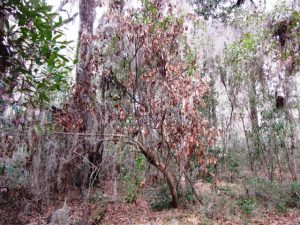You’ve probably heard people refer to a tree as a “bay” at some point. There are many different types of “bay” trees, but today we are going to focus on how to tell a redbay (Persea borbonia) from a sweetbay (Magnolia virginiana). These two are commonly confused because of their similar leaf shape and the fact that they both have very aromatic leaves and can be found in similar habitats. While these species come from a common ancestor, they are in two different tree families, so let’s see what makes them different:
Flowers
The redbay tree is in the Laurel family (Lauraceae) as compared to the sweetbay tree which is in the Magnolia family (Magnoliaceae). This is important to know for a couple reasons. First, these two plant families showcase very different flowers which can prove helpful in identification. The flowers of plants in the Lauraceae family are mostly small green, yellow, or white and found in clusters. Flowers in the Magnoliacea family are large, white and showy. Sweetbay flowers appear in summer to fall whereas redbay flowers in spring to summer. Easy enough if you have the flowers in hand, but if not, check out the “Leaves” and “Fruit” sections below.

![By Photo by and (c)2008 Derek Ramsey (Ram-Man). Co-attribution must be given to the Chanticleer Garden. [GFDL (http://www.gnu.org/copyleft/fdl.html) or CC-BY-SA-3.0 (http://creativecommons.org/licenses/by-sa/3.0/)], from Wikimedia Commons](https://blogs.ifas.ufl.edu/pinellasco/files/2018/05/Sweetbay_Magnolia_Magnolia_virginiana_Flower_Closeup_2146px_wiki-commons-300x279.jpg)

Leaves
As previously mentioned, these trees have similar shaped leaves, darker on top, lighter on the bottom and give off a nice aroma when crushed. Honestly, this is a tough one if all you had was the leaf, but look closely and there are some differences to note. In general the underside of the sweetbay leaf is whiter due to a waxy coating and fine layer of silvery hairs. The underside of the redbay leaf is also hairy, but the hairs are rust-colored dulling the underlying green color. If you rub the underside of the sweetbay leaf it will remove the waxy coating revealing a bright green underneath.

Fruit
If you have the fruit in hand, you are golden because the fruit of these two species look nothing alike. Redbay trees produce a shiny, dark blue, oblong drupe (one seeded…well…99% of the time). It’s only about a ½ inch in size maturing between September and October. Sweetbay’s fruit on the other hand mature between July and October, is about two inches long, looking more like the cone of a pine tree. This cone-like structure is holds several bright-red seeds. If you’re familiar with the fruit of a southern magnolia tree (Magnolia grandiflora), then you’ve got some idea of what to look for with a sweetbay fruit.

![By Photo (c)2007 Derek Ramsey (Ram-Man) [GFDL 1.2 (http://www.gnu.org/licenses/old-licenses/fdl-1.2.html) or CC BY-SA 2.5 (https://creativecommons.org/licenses/by-sa/2.5)], from Wikimedia Commons](https://blogs.ifas.ufl.edu/pinellasco/files/2018/05/Sweetbay_Magnolia_Magnolia_virginiana_Berries_1800px_wiki-commons-300x283.jpg)
If you enjoyed this series and would like to read more about commonly confused plants and animals in Florida, you can find more here:
https://blogs.ifas.ufl.edu/global/tag/commonly-confused/
Sources: Native Trees of the Southeast: An Identification Guide by L. Katherine Kirkman, Claud L. Brown and Donald J. Leopold. https://www.britannica.com/plant/Laurales#ref996936 https://www.britannica.com/plant/Magnoliaceae
 0
0
